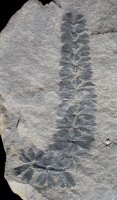Sphenophyllum
This was a herbaceous plant. The leaflets are (as in all horsetails)
arranged in whorls, but the triangular shape of the leaflets is characteristic.
They are broadest on top. On this basic pattern many variations occur in
the different species. But leaflets on the same plant also can have different
shapes. The leaflets on the main axis for example are often laciniate.
In Graissessac we have only come across one species but this one in great
numbers.
Sphenophyllum
oblongifolium
 The whorls
of this species consist of six leaflets in by far most cases, unequal in
length, which are arranged in a very characteristic way: like a bow ty. They
are always preserved without damage which is an indication that they were
attached obliquely to the axis (to catch as much light as possible). The
whorls of the thicker stems however are often folded at touching the
ground. These leaflets were probably perpendicular to the stem. These leaflets
are also differently shaped. They are often long and narrow, nearly needle-like.
Some of these narrow leaflets even bear a little hook at the end. The branches
of this plant could be very long.
The whorls
of this species consist of six leaflets in by far most cases, unequal in
length, which are arranged in a very characteristic way: like a bow ty. They
are always preserved without damage which is an indication that they were
attached obliquely to the axis (to catch as much light as possible). The
whorls of the thicker stems however are often folded at touching the
ground. These leaflets were probably perpendicular to the stem. These leaflets
are also differently shaped. They are often long and narrow, nearly needle-like.
Some of these narrow leaflets even bear a little hook at the end. The branches
of this plant could be very long.
It is thought that this plant was not a real climbing plant, but that it
hung over other plants and plants of his own kind (like cleavers and blackberry
do).
We have also found spore cones of this species. Click on the photo for more information.